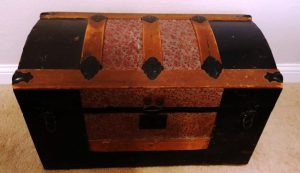 The clickety-clack of my great-grandmother’s ‘old lady shoes’[1] resonated as I toddled after her down the narrow hallway to the old trunk. There, in that back bedroom she and I would sit in the dark brilliance of polished woods, with the old trunk somehow beckoning us as if the face of some minor deity or oracle. Indeed, my great-grandmother treated the old trunk as if it held all the wonders of the world, which, in many ways, it certainly did (and still does…). Continue reading The grafting trunk
The clickety-clack of my great-grandmother’s ‘old lady shoes’[1] resonated as I toddled after her down the narrow hallway to the old trunk. There, in that back bedroom she and I would sit in the dark brilliance of polished woods, with the old trunk somehow beckoning us as if the face of some minor deity or oracle. Indeed, my great-grandmother treated the old trunk as if it held all the wonders of the world, which, in many ways, it certainly did (and still does…). Continue reading The grafting trunk
Category Archives: American History
The Wentworth connection

As Gary Boyd Roberts announced yesterday, Meghan Markle has a distant kinship to Prince Harry through their shared descent from Sir Philip Wentworth (died 1464) and his wife Mary Clifford. While Gary continues to work on much of Meghan’s American ancestry, especially her forebears in colonial New England, I’ve composed the chart at left from his notes. This outlines the three closest kinships between Meghan and Harry that have so far been identified – two through Harry’s mother and one through his father. As Gary has noted, there are hundreds of other ways they would be distantly related.
I’ve also been working on Meghan Markle’s American ancestors, so stay tuned! Continue reading The Wentworth connection
Bunching pensions
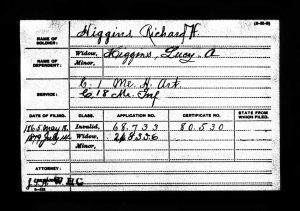 I wrote two years ago about the incredible value of Civil War pensions, but a recent example reminded me that occasionally just getting a valuable pension may be challenging as well. Whenever I realize a Civil War pension exists, whether for a book project or an article, I almost always request it, on the strong likelihood that it will provide further genealogical information, as well as substantial biographical data on the veteran’s life, his widow, and sometimes other family members. Continue reading Bunching pensions
I wrote two years ago about the incredible value of Civil War pensions, but a recent example reminded me that occasionally just getting a valuable pension may be challenging as well. Whenever I realize a Civil War pension exists, whether for a book project or an article, I almost always request it, on the strong likelihood that it will provide further genealogical information, as well as substantial biographical data on the veteran’s life, his widow, and sometimes other family members. Continue reading Bunching pensions
‘To have his family around him’

As a genealogist, I have so much to give thanks for. Soon after I started my genealogical quest, I discovered that the Nantucket Historical Association had correspondence from my great-great-great-grandfather[1] in their collections. Of course I was anxious to read it and asked for copies … not knowing that there were more than eighty letters, many of them comprising multiple pages!
It took a while to accustom myself to my ancestor’s writing, since he adopted a sort of modified scripto continua, with virtually no punctuation or capital letters at the start of sentences. Much of the correspondence was dry, relating to business transactions, but there were also many droll comments and insights into the character and activities of the extended family. Continue reading ‘To have his family around him’
The thousandth post
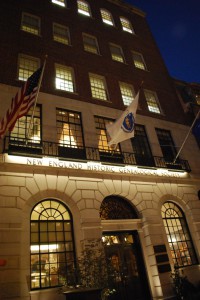 Today marks the one-thousandth Vita Brevis post since the blog launched in January 2014. The blog’s pages have been accessed more than one-and-a-half million times, and by my (not very scientific) count the following eighteen posts have led the field, read by more than one hundred thousand readers.
Today marks the one-thousandth Vita Brevis post since the blog launched in January 2014. The blog’s pages have been accessed more than one-and-a-half million times, and by my (not very scientific) count the following eighteen posts have led the field, read by more than one hundred thousand readers.
By far and away the most-read post at Vita Brevis is Chris Child’s August 2014 account of Robin Williams’s maternal ancestry. The circumstances of Williams’s death, and the affection he had inspired in millions of Americans, made the post a place to stop and reflect about what he had meant to members of the genealogical community. Continue reading The thousandth post
Fadeaway

I’ve always wanted to know more about the life of my great-grandmother Opal Young (1895–1978). To do this, I decided to see what researching her siblings might reveal about her. By and large, information about her siblings has been limited to meager ‘raw data.’ An interesting exception to this has been the life of my great-grandmother’s brother John Alfred Young (1890–1960). He is called Johnnie on the back of this Hitchcock-like cameo – it is the only known photograph to show him.[1]
Johnnie Young came to California about the time his sister Opal did in the late 1920s. Their lives as children back in Kansas seems to have been pretty normal – other than there were a LOT of people living with them in the Young household.[2] Continue reading Fadeaway
An interesting dinner party

A previous post about former President John Quincy Adams and his son visiting Nantucket listed their dining partners at a meal in the tiny village of Siasconset, on the eastern edge of the island. Most were family members of the inn’s proprietress, Betsey Cary, and all but one could conclusively be identified as island residents or relatives. The only nebulous person (and he would really love that term!) was R. T. Paine. After going down various rabbit holes trying to determine who he was, I gave up … but editor Scott Steward came up with a likely candidate: Robert Treat Paine (1803–1885).
In his own right, this gentleman was an attorney of some prominence, with a passion for astronomy and meteorology; at his death he left an “astronomical” endowment to Harvard for that purpose. His own accomplishments, however, were overshadowed by those of his father, a brilliant poet[1] … and most especially by the grandfather for whom he was named. Continue reading An interesting dinner party
Even unto death
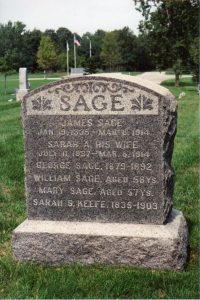 There is a family story that is slowly becoming legend as the generations pass. When the mood turns nostalgic and sentimental at family gatherings, someone will inevitably tell the story of the Sages and the train.
There is a family story that is slowly becoming legend as the generations pass. When the mood turns nostalgic and sentimental at family gatherings, someone will inevitably tell the story of the Sages and the train.
The story tells how my great-great-great-grandparents, James Sage and Sally Hastings, died at the same moment on 8 March 1914, when they were struck by a train in Libertyville, Illinois. They were returning home from visiting their son, who had just dropped them off at the station. As the train arrived, they attempted to cross the tracks to the far platform, but did not succeed. It is not surprising that they were unable to make it quickly across the tracks, for they were elderly, 79 and 77. It is also not surprising that they attempted it, too, as James Sage had been foolish around a train at least once before, losing a foot some years earlier, also in a train accident. Continue reading Even unto death
Dower vs. inheritance
 After my previous post, the question came up about whether a widow’s dower right in her husband’s property is an “inheritance,” since, as we traditionally see the term being used in seventeenth-century New England, it is held only for the widow’s lifetime and reverts to her children on her death.
After my previous post, the question came up about whether a widow’s dower right in her husband’s property is an “inheritance,” since, as we traditionally see the term being used in seventeenth-century New England, it is held only for the widow’s lifetime and reverts to her children on her death.
However, I found the following on Wikipedia: “Usually, the wife was free from kin limitations to use (and bequeath) her dower to whatever and whomever she pleased. It may have become the property of her next marriage, been given to an ecclesiastical institution, or been inherited by her children from other relationships than that from which she received it.” Continue reading Dower vs. inheritance
Things lost and found
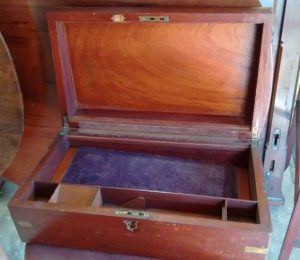 As a member of my local historic preservation commission, as well as my family’s de facto family historian and custodian of All Things Family Memorabilia, I often encounter the decision of what to preserve, what to donate or sell, and what to demolish. Historic preservation of buildings is a complex and sometimes contentious topic best left for other writers. But what about all those smaller treasures our ancestors left for us, assuming that we would value them, cherish them, and preserve them as they had (even if we don’t know what or who they are)? Continue reading Things lost and found
As a member of my local historic preservation commission, as well as my family’s de facto family historian and custodian of All Things Family Memorabilia, I often encounter the decision of what to preserve, what to donate or sell, and what to demolish. Historic preservation of buildings is a complex and sometimes contentious topic best left for other writers. But what about all those smaller treasures our ancestors left for us, assuming that we would value them, cherish them, and preserve them as they had (even if we don’t know what or who they are)? Continue reading Things lost and found